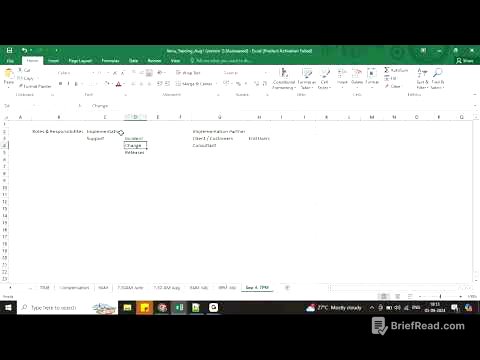TLDR;
This YouTube video by The Trading Academy provides a comprehensive analysis of gold trading strategies and how to analyse the US dollar. It covers market structure, liquidity, supply and demand, and entry models for gold, and explains the importance of understanding the US dollar's drivers, including Federal Reserve policies, economic data, risk sentiment, and geopolitical stability. The presenter also shares insights on how to track and interpret economic news to improve trading decisions.
- Gold trading strategy explained with market structure, liquidity, supply and demand analysis.
- Importance of US dollar analysis due to its global reserve currency status and impact on commodity prices.
- Key drivers of the US dollar: Federal Reserve, economic data, risk sentiment, and geopolitical stability.
Introduction [0:13]
The presenter welcomes viewers to the stream, noting the rainy weather in Amsterdam. He mentions that gold has been rising due to news related to the Russia-Ukraine conflict, where Russia has promised to strike back and Ukraine reportedly destroyed 40 Russian planes. He also highlights the bullish technical perspective on gold, setting the stage for a discussion on a specific gold trade.
Gold Trading Strategy [2:42]
The presenter outlines a five-point strategy for trading gold, which includes analysing market structure, liquidity, supply and demand, premium versus discount (PVD), and entry models. He identifies the swing low and swing high, noting the impulsive and retracement phases. The market structure is currently bullish. Liquidity is assessed by looking at equal lows and V-shaped reversals, indicating buyer interest. A daily demand zone has been tapped, and the market has retraced into discount pricing, further confirming the potential for upside. For entries, the presenter looks for confirmation in the form of market structure shifts on lower timeframes like the 4-hour or 1-hour charts.
Entry Model and Timeframe Analysis [5:34]
The presenter explains how to refine entry points by using lower timeframes such as the 4-hour and 1-hour charts. He notes that the internal downtrend has been broken, confirming the market's readiness to move higher. He advises against waiting for perfect retracements to demand zones, suggesting instead to identify liquidity and use that as a basis for entry. He points out a liquidity low on the 15-minute timeframe, which led to an aggressive V-shaped reversal. The presenter also discusses how the market consolidated before breaking out, forming a 1-hour demand zone that broke market structure. He highlights a trade taken by Ruter on futures with a 1-to-3 risk-to-reward ratio, calling it a textbook example of a good trade setup.
Introduction to Analysing the US Dollar [10:22]
The presenter transitions to the main topic: how to analyse the US dollar. He notes that this is a frequently asked question and he will walk through analysing the dollar during the month of May, considering data and fundamentals.
Why the Dollar Matters [11:59]
The presenter explains why understanding the US dollar is crucial. It is the global reserve currency, held by over 60% of central banks, and the world's most trusted currency. Commodities like oil and gold are priced in US dollars, driving global demand. The dollar is involved in 80-90% of all FX trades and influences market direction. It also serves as a risk sentiment indicator: when fear increases, money flows into the dollar, but when risk appetite is high, the dollar weakens. The dollar's strength or weakness affects major pairs like EURUSD, USDJPY, and GBPUSD, as well as most cross pairs.
Dollar's Influence on Currency Pairs [14:36]
The presenter illustrates how the dollar dictates the general market direction. He compares the indexes of risk-on currencies (New Zealand dollar, Canadian dollar, and Australian dollar) and risk-off currencies (Swiss Franc and Japanese Yen), noting that the risk-on currencies tend to move in the same direction. He advises focusing on the dollar's movements rather than individual economies, as the dollar's influence is paramount. In current market conditions, the dollar has somewhat decoupled, with the Swiss Franc and Japanese Yen moving together inversely to the risk-on currencies. The presenter recommends trading the extremes against each other, rather than cross pairs, for potentially faster and more significant movements.
News Impact and Market Dynamics [17:36]
The presenter explains that news events significantly impact currency movements. Positive news for the dollar tends to push the New Zealand dollar, Canadian dollar, and Australian dollar upwards, while negative news pushes the Swiss Franc and Japanese Yen upwards.
Drivers of the US Dollar [18:10]
The presenter outlines the key drivers of the US dollar, including the Federal Reserve, US economic data, risk sentiment, and geopolitical stability. He notes that higher interest rates typically strengthen the dollar as foreign investors seek better returns. Key economic data to watch include inflation (CPI and PCE), job growth (NFP), GDP, and retail sales. High inflation often leads to rate hikes, boosting the dollar. Strong job growth and GDP attract foreign capital, increasing demand for the dollar. Strong retail sales indicate more spending, leading to higher demand and inflation, which in turn strengthens the dollar.
Risk Sentiment and Geopolitical Factors [22:53]
The presenter discusses the role of risk sentiment, noting that the US has traditionally been seen as a safe haven due to its stable institutions and deep capital markets. However, current uncertainty has led investors to move capital out of the dollar and into currencies like the Euro, Swiss Franc, and Japanese Yen, as well as gold. Geopolitical stability is another critical factor. Events like the Russia-Ukraine conflict, tensions in the Middle East, trade wars, and the situation with Taiwan can all impact the dollar's value.
Economic Indicators and Market Examples [24:37]
The presenter provides examples of how economic indicators have affected the US dollar. He notes that positive NFP data in early May led to a rise in the dollar. Conversely, lower-than-expected CPI and PPI data caused the dollar to decline. He also discusses how news about tariffs influenced market movements, with unlawful tariffs initially pushing the market higher, followed by a reversal when a judge allowed for the possibility of reimposing them. The presenter recommends tracking these numbers in a spreadsheet and analysing how they affect the market to improve trading decisions.
Q&A and Market Analysis [29:41]
The presenter answers viewers' questions and analyses current market conditions. He notes that the Euro and GBP move somewhat independently, with the Euro currently benefiting from the dollar's weakness. He discusses the importance of market structure and fractals in determining potential movements for EURUSD. Recent news about a phone call between Trump and the Chinese president has caused a spike in the dollar and influenced other currency pairs. The presenter also analyses gold, noting its decline due to increased risk-on sentiment. He advises caution with gold, suggesting waiting for accumulation and manipulation phases before entering trades.









